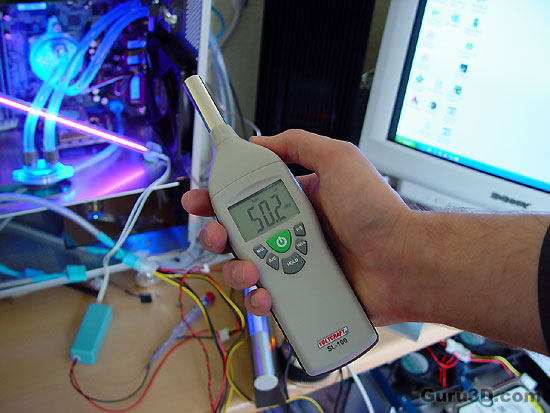Page 3
I got the power & am not afraid to use it!
What we always do with new graphics' cards, we measure the wattage peak with the help of a wattage meter. Slight side note, you are looking at the overall usage of the entire PC. The meter is placed between the power connector and the PSU. So please understand that using a Wattage meter is not the most reliable way of measuring power consumption. This is how much power is being consumed, taking the measurement from the wall socket, and you need to look at the results as being an indication and not an exact science.
Let's have a look at some X1000 products and specifically the X1950 XTX product in regards to total PC power consumption:
|
|||||||||||||||||||||||||||||
The methodology is simple: we look at the peak Wattage during a 3DMark05 session to verify power consumption. You are not looking at the power consumption of the graphics card, but the consumption of the entire PC. The graphics card obviously consumes way more than 75 Watts at peak during 3D gaming.
I suggest
you need a 420 Watt PSU minimum but better is always recommended especially if you keep SLI or Crossfire in mind as a future upgrade. When you buy a new PSU then look at the packaging and check the 12 volts rail on Ampere, 20 AMPS should be fine.Here are some indications on what would happen if your PSU can't cope with the load:
- unusual fluctuating 3D gaming performance
- crashing games
- spontaneous resetting PC
- freezes during gameplay
- PSU overload can cause it to break down or shut down.
T
emperatures of the graphics cardThe new thermal design cooler on the X1950 XTX surely does it's job well. The cooler we saw before, well, take a good look at our latest HiS reviews. The advantage of the cooler is simple, it takes colder air from the ambient air in the PC, uses it to cool down the graphics core and exhausts the hot air outside the PC.
The major advantage here is obviously that the heat is not dumped inside your PC, this means less heat on the other components. Good stuff.
| Radeon X1950 XTX | 42 |
Roughly 69 Degrees C when it's peaking .. that's really good.
Anyway, we simply loop a 3Dmark 06 session for a while and look at the peak temperature. In this case expect roughly a 100% utilization temperature of 69 Degrees C.
Noise Levels coming from the graphics card ![]()
When graphics cards produce a lot of heat usually that heat needs to be transported away from the hot core as fast as possible. Often you'll see massive active fan solutions that can indeed get rid of the heat, yet all the fans these days make the PC a noisy son of a gun. I'm doing a little try out today with noise monitoring, so basically the test we do is extremely subjective. We bough a certified dBA meter and will start measuring how many dBA originate from the PC. Why is this subjective you ask? Well, there is always noise in the background, from the streets, from the HD, PSU fan etc etc, so this is by a mile or two not a precise measurement. You could only achieve objective measurement in a sound test chamber.
The human hearing system has different sensitivities at different frequencies. This means that the perception of noise is not at all equal at every frequency. Noise with significant measured levels (in dB) at high or low frequencies will not be as annoying as it would be when its energy is concentrated in the middle frequencies. In other words, the measured noise levels in dB will not reflect the actual human perception of the loudness of the noise. That's why we measure the dBa level. A specific circuit is added to the sound level meter to correct its reading in regard to this concept. This reading is the noise level in dBA. The letter A is added to indicate the correction that was made in the measurement.
|
| ||||||||||||||||||||||||||||||
|
Bedroom at night |
30 dBA |
Quiet | |||||||||||||||||||||||||||||
|
Broadcast studio |
20 dBA |
| |||||||||||||||||||||||||||||
|
Rustling leaves |
10 dBA |
Barely audible | |||||||||||||||||||||||||||||
We startup a benchmark, we take the dBA meter, move away 75 CM and then aim the device at the active fan on the graphics card.
We measure roughly 45 dBa on the PC, which is to be considered a quiet to moderate noise level coming from the PC. Not bad .. but on occasionally the GPU will get slightly hotter than 70 Degrees C for just a second, and then the noise level goes up towards almost 50 DBa. Once that happens you can definitely hear the cooling solution.
Overall not at all bad though.

A reference shot of how we measure in the Guru3D lab.
